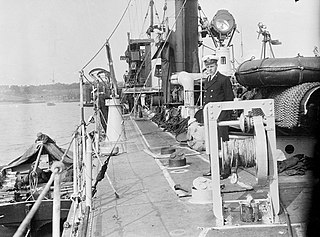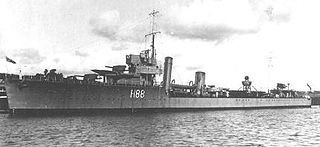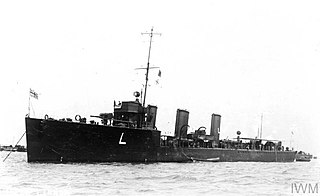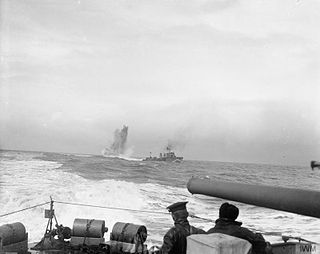Related Research Articles

The first HMS Zulu was a Tribal class destroyer launched 16 September 1909 at Hawthorn Leslie Shipyard and commissioned in March 1910. She was mined during the First World War, on 27 October 1916 off Dover in a minefield lain by the Imperial German submarine UC-1. Her stern was blown off and sank, but the forward section remained afloat. It was towed into port and attached to the stern of Nubian, which had been torpedoed, to form a new destroyer named HMS Zubian.

HMS Laforey was the lead ship of her class of destroyer built for the Royal Navy. Launched a year before the First World War began, she was attached to the Dover Patrol. Laforey saw action in several engagements with German torpedo boats, including the Battle off Noordhinder Bank and the action of 17 March 1917. Laforey was sunk in 1917 by a British mine after escorting several freighters to France. She was named for Francis Laforey, captain of HMS Spartiate at the Battle of Trafalgar in 1805.
HMS Faulknor was a British destroyer of the First World War. She was purchased by the Royal Navy whilst still under construction in Britain for the Chilean Navy who had ordered her in 1912 as part of the Almirante Lynch class. She was renamed after the Faulknor family of British nineteenth century naval officers.
HMS Phoebe was an Admiralty M-class destroyer built for the Royal Navy during the First World War. She took part in the Zeebrugge Raid in 1918 and was sold for scrap in 1921.

HMS Attentive was one of two Adventure-class scout cruisers built for the Royal Navy during the first decade of the 20th century. Completed in 1905 the ship was placed in reserve until she was commissioned in 1907 as part of the Home Fleet. She then spent the next seven years moving on and off of active service in British waters. The ship sank one destroyer and damaged two others in collisions. Attentive was assigned to coastal defence duties when the First World War began in 1914, and spent most of the war assigned to the Dover Patrol. She played a minor role in the Zeebrugge Raid in early 1918 and was then assigned to escort convoys to Gibraltar. The ship was sent to the White Sea later in the year to support the unsuccessful North Russia intervention in the Russian Civil War. Attentive paid off at the end of 1918 and was sold for scrap in 1920.
HMS Lassoo was a Laforey-class destroyer built for the Royal Navy during the 1910s.
HMS Ophelia was an Admiralty M-class destroyer built for the Royal Navy during the First World War, entering service in 1916. The ship served at the Battle of Jutland on 31 May/1 June 1916, and sank a German submarine in 1918. She was sold for scrap in 1921.

HMS Wakeful was a W-class destroyer of the Royal Navy, built under the 1916–1917 Programme in the 10th Destroyer order. Wakeful was assigned to the Grand Fleet after completion, and served into the early years of the Second World War. Wakeful was torpedoed and sunk during Operation Dynamo by a German E-Boat on 29 May 1940.

HMS Meteor was a Thornycroft M-class destroyer that served in the British Royal Navy. Meteor saw extensive service throughout World War I, maintaining continuous operations both as a convoy escort and in harbour protection.

HMS Lennox was a Laforey-class destroyer built for the Royal Navy during the 1910s.
HMS Narborough was an Admiralty M-class destroyer built for the Royal Navy during the First World War. She was wrecked after running aground in 1918.

HMS Tempest was an R-class destroyer of the Royal Navy, built by Fairfield Shipbuilding and Engineering Company at Govan on Clydeside and launched on 26 January 1917 during the First World War.
HMS Murray was a Royal Navy Admiralty M-class destroyer. Ordered before the outbreak of war, she was therefore the first of her class to enter operation during the early months of the First World War. She was also the first vessel of the Royal Navy to carry the name HMS Murray.

HMS Torrent was a Royal Navy R-class destroyer constructed and then operational in the First World War. She was sunk, with most of her crew in 1917. On 23 December 1917 Surprise, HMS Torrent, and Tornado sank after entering an Imperial German minefield.

HMS Surprise was a Royal Navy R-class destroyer constructed and then operational in the First World War. She was sunk, with most of her crew in 1917. On 23 December 1917 HMS Surprise, Torrent, and Tornado sank after entering an Imperial German minefield.

HMS Partridge was a Royal Navy Admiralty M-class destroyer constructed and then operational in the First World War, later being sunk by enemy action in 1917. The destroyer was the sixth Royal Navy vessel to carry the name HMS Partridge.
HMS Pheasant was one of 85 Admiralty M-class destroyers built during the First World War for the Royal Navy. She hit and was sunk by a mine in 1917.

HMS Manly was a Yarrow M-class destroyer of the British Royal Navy. Built by the Scottish shipbuilder Yarrow between 1913 and 1914, Manly served during the First World War. She formed part of the Harwich Force in the early years of the war, and then later in the English Channel as part of the Dover Patrol taking part in the Zeebrugge Raid in 1918. She survived the war, and was sold for scrap in 1920.
HMS Melpomene was a Medea-class destroyer of the British Royal Navy. She was one of four destroyers, of similar design to the British M-class ordered by Greece in June 1914, which the British purchased during construction owing to the outbreak of the First World War.

HMS Mounsey was a Yarrow M-class destroyer of the British Royal Navy. Built by the Scottish shipbuilder Yarrow in 1914–1915, Mounsey served in the Grand Fleet during the First World War, and took part in the Battle of Jutland. The following year she saw combat against German submarines, and in 1918 she helped rescue crew and passengers aboard the damaged troopship Otranto. She was sold for scrap in 1921.
References
- ↑ "Destroyers - World War One". Harwich and Dovercourt. Retrieved 5 October 2016.
- ↑ Conway's All the World's Fighting Ships 1906–1921, Conway Publishing, 1997. p. 79.
- ↑ Gardiner & Gray 1985 , p. 77
- ↑ Friedman 2009 , pp. 132, 134–135
- ↑ McBride 1991 , p. 37
- 1 2 Gardiner & Gray 1985 , p. 79
- ↑ Friedman 2009 , pp. 155–156
- ↑ Gardiner & Gray 1985 , pp. 76, 79
- ↑ Warner, P. The Zeebrugge Raid, Pen and Sword, 2008.p.155
- ↑ "HMS North Star". Wrecksite. Retrieved 5 October 2016.
- ↑ "British Admiralty Statement on the Zeebrugge Raid, 22-23 April 1918". First World War.com. Retrieved 5 October 2016.